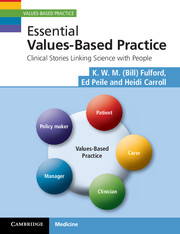Book contents
- Frontmatter
- Review quotes
- Contents
- Foreword
- Acknowledgements
- A bold claim to start this book
- Prologue: linking science with people
- Part 1 Values, individuals and an overview of values-based practice
- Part 2 The clinical skills for values-based practice
- Part 3 Relationships in values-based practice
- Part 4 Science and values-based practice
- Part 5 Bringing it all together
- 13 A good (enough) death: dissensus in end-of-life care
- 14 “It's my back, Doctor!” (episode 3): building a shared framework for values-based practice
- Postcript: the small change of care
- A bold claim to end this book
- Appendix A Values-based practice summary and definitions of key terms
- Appendix B Values-based practice teaching framework
- Index
14 - “It's my back, Doctor!” (episode 3): building a shared framework for values-based practice
Published online by Cambridge University Press: 05 June 2012
- Frontmatter
- Review quotes
- Contents
- Foreword
- Acknowledgements
- A bold claim to start this book
- Prologue: linking science with people
- Part 1 Values, individuals and an overview of values-based practice
- Part 2 The clinical skills for values-based practice
- Part 3 Relationships in values-based practice
- Part 4 Science and values-based practice
- Part 5 Bringing it all together
- 13 A good (enough) death: dissensus in end-of-life care
- 14 “It's my back, Doctor!” (episode 3): building a shared framework for values-based practice
- Postcript: the small change of care
- A bold claim to end this book
- Appendix A Values-based practice summary and definitions of key terms
- Appendix B Values-based practice teaching framework
- Index
Summary
Topics covered in this chapter
This chapter describes how to bring together the elements of values-based practice within a framework of shared values to support balanced decision-making in clinical practice.
Other topics include:
Management of chronic low back pain
Chronicity and compliance
Protected learning time
Efficiency and effectiveness
Practice policies
Values-based commissioning
Take-away message for practice
A framework of shared values, built up between clinicians, patients, carers and managers, provides a basis for balanced decision-making on contested issues.
In this chapter, we return to the story of Dr. Gulati from Part 1 to see how the elements of values-based practice, as set out separately in the preceding chapters, came together to support her in resolving her dilemma about how to manage the demand of her patient, Roy Walker, for an off-work certificate.
The buck stops here
Dr. Gulati's reflection had helped to clarify her dilemma. There were important ancillary issues: her personal and professional obligations to Dr. Austin, and her concerns for Roy Walker's family. But the essence of her dilemma was that she was caught between two important conflicting aspects of good practice. On the one hand, she wanted to support autonomy of patient choice as an aspect of person-centered practice, while on the other hand, she had not only her societal responsibility for certification but also her responsibility to Roy Walker to act in his clinical best interests as indicated by established evidence on chronicity and low back pain.
Information
- Type
- Chapter
- Information
- Essential Values-Based PracticeClinical Stories Linking Science with People, pp. 183 - 200Publisher: Cambridge University PressPrint publication year: 2012
